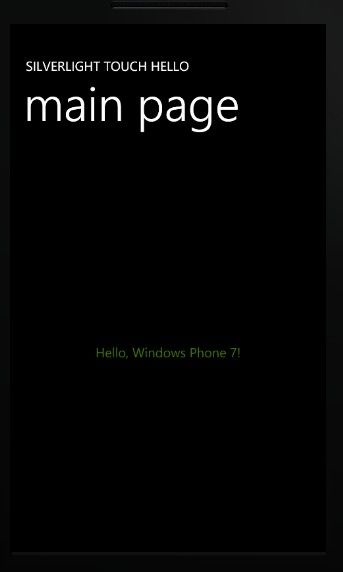Windows Phone 7 触摸编程-单点触摸利用Touch.FrameReported事件
在WP7上Silverlight还支持多点触摸,有两种不同的编程模式:
1、低级别使用Touch.FrameReported事件
2、高级别的使用UIElement类中定义三个事件:ManipulationStarted,ManipulationDelta和ManipulationCompleted。
一、
第一种低级别的触摸编程是使用类TouchPoint,一个TouchPoint的实例代表一个特定的手指触摸屏幕。
TouchPoint的四个属性:
• 动作的类型-枚举TouchAction,有Down, Move和Up四个值表示手指的按下、移动和离开。
• 位置的类型-Point的位置,以左上角为参考点。
• 大小的类型-Size,支持接触面积(手指的压力大小),但Windows 7不会返回电话有用的值。
• 接触设备的类型TouchDevice。
该TouchDevice对象有两个得到只读属性:
•ID int类型,用来区分手指,一个特定的手指有一个唯一测ID来触发所有的上下移动的事件。
• DirectlyOver UIElement的类型,你手指的最顶层元素。
使用Touch.FrameReported事件处理程序:
Touch.FrameReported + = OnTouchFrameReported;
OnTouchFrameReported 方法格式如下:
void OnTouchFrameReported(object sender, TouchFrameEventArgs args)
{
…
}
TouchFrameEventArgs args事件有3个方法:
• GetTouchPoints(refElement)返回一个TouchPointCollection 获取多个接触点的集合
• GetPrimaryTouchPoint(refElement)返回一个TouchPoint 获取第一个手指接触点
• SuspendMousePromotionUntilTouchUp()
返回值是相对于传递的参数元素接触点的相对值。
当传递null的时候,GetTouchPoints得到Position属性相对于应用程序的左上角。
实例单点触摸改变字体的颜色

 代码
代码
<
phone:PhoneApplicationPage
x:Class
="SilverlightTouchHello.MainPage"
xmlns
="http://schemas.microsoft.com/winfx/2006/xaml/presentation"
xmlns:x
="http://schemas.microsoft.com/winfx/2006/xaml"
xmlns:phone
="clr-namespace:Microsoft.Phone.Controls;assembly=Microsoft.Phone"
xmlns:shell
="clr-namespace:Microsoft.Phone.Shell;assembly=Microsoft.Phone"
xmlns:d
="http://schemas.microsoft.com/expression/blend/2008"
xmlns:mc
="http://schemas.openxmlformats.org/markup-compatibility/2006"
FontFamily
="{StaticResource PhoneFontFamilyNormal}"
FontSize
="{StaticResource PhoneFontSizeNormal}"
Foreground
="{StaticResource PhoneForegroundBrush}"
SupportedOrientations
="PortraitOrLandscape"
Orientation
="Portrait"
mc:Ignorable
="d"
d:DesignWidth
="480"
d:DesignHeight
="768"
shell:SystemTray.IsVisible
="True"
>
<!--
LayoutRoot contains the root grid where all other page content is placed
-->
<
Grid
x:Name
="LayoutRoot"
Background
="Transparent"
>
<
Grid.RowDefinitions
>
<
RowDefinition
Height
="Auto"
/>
<
RowDefinition
Height
="*"
/>
</
Grid.RowDefinitions
>
<!--
TitlePanel contains the name of the application and page title
-->
<
StackPanel
x:Name
="TitlePanel"
Grid.Row
="0"
Margin
="12,17,0,28"
>
<
TextBlock
x:Name
="ApplicationTitle"
Text
="SILVERLIGHT TOUCH HELLO"
Style
="{StaticResource PhoneTextNormalStyle}"
/>
<
TextBlock
x:Name
="PageTitle"
Text
="main page"
Margin
="9,-7,0,0"
Style
="{StaticResource PhoneTextTitle1Style}"
/>
</
StackPanel
>
<!--
ContentPanel - place additional content here
-->
<
Grid
x:Name
="ContentPanel"
Grid.Row
="1"
Margin
="12,0,12,0"
>
<
TextBlock
Name
="txtblk"
Text
="Hello, Windows Phone 7!"
Padding
="0 22"
HorizontalAlignment
="Center"
VerticalAlignment
="Center"
/>
</
Grid
>
</
Grid
>
<!--
Sample code showing usage of ApplicationBar
<phone:PhoneApplicationPage.ApplicationBar>
<shell:ApplicationBar IsVisible="True" IsMenuEnabled="True">
<shell:ApplicationBarIconButton x:Name="appbar_button1" IconUri="/Images/appbar_button1.png" Text="Button 1"></shell:ApplicationBarIconButton>
<shell:ApplicationBarIconButton x:Name="appbar_button2" IconUri="/Images/appbar_button2.png" Text="Button 2"></shell:ApplicationBarIconButton>
<shell:ApplicationBar.MenuItems>
<shell:ApplicationBarMenuItem x:Name="menuItem1" Text="MenuItem 1"></shell:ApplicationBarMenuItem>
<shell:ApplicationBarMenuItem x:Name="menuItem2" Text="MenuItem 2"></shell:ApplicationBarMenuItem>
</shell:ApplicationBar.MenuItems>
</shell:ApplicationBar>
</phone:PhoneApplicationPage.ApplicationBar>
-->
</
phone:PhoneApplicationPage
>
 代码
代码
using
System;
using
System.Windows.Input;
using
System.Windows.Media;
using
Microsoft.Phone.Controls;
namespace
SilverlightTouchHello
{
public
partial
class
MainPage : PhoneApplicationPage
{
Random rand
=
new
Random();
Brush originalBrush;
public
MainPage()
{
InitializeComponent();
originalBrush
=
txtblk.Foreground;
Touch.FrameReported
+=
OnTouchFrameReported;
}
void
OnTouchFrameReported(
object
sender, TouchFrameEventArgs args)
{
TouchPoint primaryTouchPoint
=
args.GetPrimaryTouchPoint(
null
);
if
(primaryTouchPoint
!=
null
&&
primaryTouchPoint.Action
==
TouchAction.Down)
{
if
(primaryTouchPoint.TouchDevice.DirectlyOver
==
txtblk)
{
txtblk.Foreground
=
new
SolidColorBrush(
Color.FromArgb(
255
, (
byte
)rand.Next(
256
),
(
byte
)rand.Next(
256
),
(
byte
)rand.Next(
256
)));
}
else
{
txtblk.Foreground
=
originalBrush;
}
}
}
}
}
